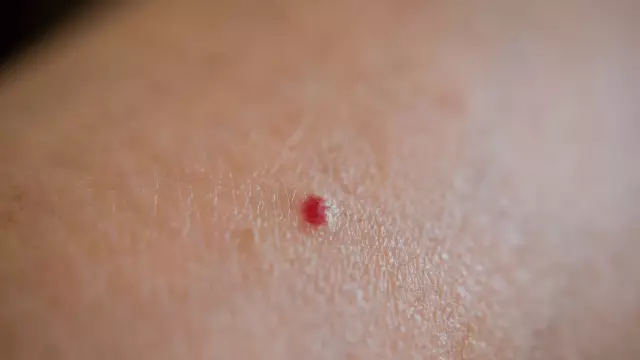- Author Rachel Wainwright [email protected].
- Public 2023-12-15 07:39.
- Last modified 2025-11-02 20:14.
Angioma
Angioma is a benign vascular tumor-like neoplasm consisting of blood and lymph vessels with dilated walls. Most often, angioma is a congenital developmental anomaly. As a result of the pathological connection of arteries and veins, arterial blood, bypassing the capillaries, enters directly from the arteries into the veins. Angioma is a type of birthmark. It is most often found in the brain, but it can also occur in any other organs, for example, on the lower and upper limbs, in the spinal cord, on the ears. Angioma of the brain can grow to a huge size and occupy the lobes of the brain.
Types of angioma

Cavernous (cavernous) angiomas are pulsating formations of a dark red or purple color, consisting of cavities filled with blood. They look like spots that rise above the level of the skin. Cavernous angiomas differ from other types in spongy structure. This type of tumor is most often localized subcutaneously and very rarely grows into bone and muscle tissue. To the touch, the angioma is elastic and soft, it easily shrinks when pressed, easily assuming its primary appearance. Cavernous angiomas are prone to bleeding and ulceration. Bleeding and ulceration are predisposing factors for the development of secondary infection. In some cases, an increase in the supply of an angioma leads to a significant increase in the size of those parts of the body on which it is localized.
Venous angiomas are soft formations of various sizes, characterized by progressive autonomous growth. Venous angiomas are usually referred to as benign tumors.
Venous angiomas are represented by a set of numerous cavernous thin-walled cavities that are connected to each other. These neoplasms are localized in the subcutaneous fat, muscle tissue, and on the skin. The color of the spots usually ranges from dark blue to brown.
Branched angioma is a rather rare disease that manifests itself on the limbs, less often on the face and head. This type of pathology is represented by tortuous strands, and sometimes whole tangles of arteries with dilated branches.
Intraosseous angiomas usually develop on the bones of the skull. These formations can provoke repeated bleeding. This angioma is determined by X-ray examination.
Angioma symptoms
Symptoms of angioma can occur at any age, but most often they appear over the age of twenty. The most common symptoms of angioma are a feeling of heaviness in the limbs, hypertrichosis, difficulty in swallowing and breathing. The development of angioma is often accompanied by painful sensations in the area of its localization, short-term neurological symptoms, and hyperthermia.
Symptoms of cerebral angioma include headaches, hypertension, increased intracranial pressure, epileptic seizures, dementia, and stroke.
Depending on the location, symptoms of cerebral angioma may be muscle weakness, dizziness, impaired vision, consciousness, memory, speech, coordination, paralysis of a part of the body.
Angioma treatment methods

Angiomas are treated with various methods. The main goal of treating angiomas is to stop their growth by eliminating the pathological process and restoring the normal functioning of blood vessels.
Laser treatment consists of removing the affected tissue layer by layer. The pathologically altered tissue is removed completely, until the layers of perfectly healthy tissue are exposed. The advantage of laser treatment is minimal bleeding.
Radiation treatment is applied to angiomas of a large area and complex localization (retrobulbar space, orbital region).
Diathermocoagulation is used for angiofibromas, punctate and bleeding angiomas. This method of treatment cannot be used for large and hard-to-reach tumors.
Sclerotherapy is indicated for deeply located small angiomas. As a sclerosing substance, alcohol is used, which is injected into the tumor cavity. This procedure is quite long and painful.
Hormone therapy is used for extensive lesions, progressive growth and development of angioma, critical location of the tumor, combined lesions of several anatomical areas at once.
Cryotherapy is an excellent method of treatment for angiomas of any location. This method is widely used in pediatric surgery. The advantage of the method is its painlessness, clear demarcation of the pathological focus, in the absence of bleeding.
Surgical treatment of angioma is used with a deep location of the vascular tumor. They try to carefully remove the angioma completely so as not to damage the adjacent healthy tissues surrounding it.
YouTube video related to the article:
The information is generalized and provided for informational purposes only. At the first sign of illness, see your doctor. Self-medication is hazardous to health!






